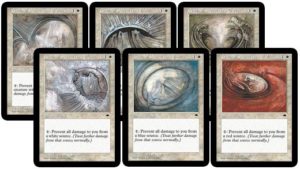Welcome to Part 5 of a 6 part series on how to design collectible games. You can find the other parts here:
Part 1: Overview
Part 2: Engine Design
Part 3: Engine Development
Part 4: Component Design
Component Development is where the rubber hits the road. Each piece must fit together in a way that doesn’t tip the scales too far one way or another.
During component development, attention shifts from the big picture to the small details. One additional point of power or recruit cost matters now. Leading up to this phase, those issues could (and should) be overlooked in favor of focus on the bigger vision of the design. Now, its time to get into the weeds.
Design vs Development
My first job in the gaming industry was as a game developer for the Vs. System trading card game. I was recruited because of my success on the Magic: the Gathering Pro Tour, during which my primary focus was to find degenerate strategies and exploit them. This skill set is incredibly valuable, but is very different from the skills of a designer. Let’s define the skills of both roles:
A great designer understands the player’s emotional experience and can create rules and components that evoke desired emotions and experiences.
A great developer understands the strategic implications of different rules and components and is able to balance them to support the design’s emotional intent.
Both roles must support each other to create a great game.
If the designer doesn’t create fun and powerful emotional experiences, the best development cannot make a good game.
If the developer completely misses the mark, then the vision of the designer will be eclipsed by degenerate strategies.
We’ve talked a lot about the great elements of design, so today we will break down how to think about developing your game.
4 Key Strategies for Game Development
1. Balance
Fundamentally, development is about balance. A balanced game is one such that no single strategy is so dominant that another strategy cannot defeat it.
Balance Does Not Mean Equal!
Your goal in development is not to make all components, cards, or strategies equally strong, only to make sure that no one is completely dominant. Part of the fun of playing collectible games is finding the more powerful strategies and components- if none are more powerful, you rob the player of the joy of discovery. Don’t try to make everything equal, just make sure the most powerful thing isn’t so powerful that the joy of discovery is lost once that thing is found.
Use Development Knobs to find Balance
Your core engine will dictate how easy it is to balance your game. Do your creatures all have one power number or two? Are there different types of costs or only one? I call these development “knobs” because each one can be turned like knobs on a tuning board to help you find a balance point. In general, the more knobs you have, the easier it is to balance your game.
You can see more about how game engine level systems can help development in my article on Depth.
2. Support Different Player Archetypes
When creating initial components, it helps to group them into general player strategy archetypes. The basic archetypes are:
Defensive– The player tries to survive long enough to set up an insurmountable late game advantage
Offensive– The player tries to win quickly, before other players can execute their strategy
Stealth– the player tries to obfuscate their position and uses misinformation to gain an edge
Combo– the player tries to combine two or more resources in a way that disproportionately gives them an edge
These are VERY loose definitions and most player strategies will involve a combination of all the above, but it can be helpful to simplify for purposes of your initial creation process. When developing collectible components, try to make sure each player archetype has some powerful ways to support their preferred strategy.
3. Establish Silver Bullets
One key tool to help ensure diversity of strategies in your game is to include Silver Bullets. Silver bullets are components that aren’t necessarily good on their own, but are devastatingly effective against some strategies.
A classic example from Magic are the circles of protection.

Each circle could stop all damage from a single color. If your opponent didn’t play that color, it was useless. If they played ONLY that color, that one card could win you the game.
If one strategy becomes too dominant, then players can use silver bullets to defeat it. This isn’t a panacea to solve all development mistakes, but it can help prevent the worst case scenario of one strategy being unbeatable. Be careful not to make your silver bullet components too powerful lest they themselves become the dominant strategy.
4. Emphasize the Fun

The unfortunate truth about component development is that you will never get it 100% right. I’ve worked with some of the most brilliant game developers in the world and spent months developing a single game release. Even with all those resources, we still made mistakes.
Huge companies that spend millions of dollars and years developing their games still make development mistakes. I can guarantee that you too will make development mistakes. The question is how do you handle it when you do?
The first rule is, when in doubt, push the fun. Pay attention to which play patterns are most enjoyable and which ones make players want to quit. Its OK if giant dragons win a lot of games, but not OK if counterspells prevent one player from ever playing a card.
The second rule is to be humble. Be prepared to admit mistakes and keep an eye out for what is changing. Collectible games are living organisms that change both in response to new content and player behavior trends.
Collectible games are so compelling because the players get to craft their own game experience from the tools you give them. Learn from your players and be ready to adapt to the game you all have created together. Tune in next time where we take all the hard work and iterations of design and prepare it for its final step- polish.



